What is Oxford Dictionary
Oxford Dictionary is a potentially unwanted application (browser extension) that falls under the category of Adware. Scammers use the name of a world famous dictionary to trick users into installing malware. Adware is considered by many to be synonymous with ‘malicious software’. It is a part of harmful programs that displays unwanted advertisements to computer users. Some examples include pop-up advertisements, push notifications or unclosable windows. Adware software can be installed onto computers via infected websites, when users open email attachments, anytime users download and install freeware.

Unwanted ads
Even worse, the Oxford Dictionary adware is able to gather your surfing history and confidential info, including passwords and credit card numbers. In the future, your privacy information can be sold to third party companies. We suggest to remove the adware, as soon as you found this problem, as it can redirect your internet browser to web-resources which may load other unwanted software on your personal computer.
How does Oxford Dictionary get on your computer
Adware software gets onto computer by being attached to certain free software. So always read carefully the install screens, disclaimers, ‘Terms of Use’ and ‘Software license’ appearing during the install procedure. Additionally pay attention for optional programs that are being installed along with the main program. Ensure that you unchecked all of them! Also, run an adblocker application that will allow to stop shady and untrustworthy web pages.
Threat Summary
| Name | Oxford Dictionary |
| Type | adware, potentially unwanted program (PUP), pop up ads, pop-ups, popup virus |
| Symptoms |
|
| Removal | Oxford Dictionary removal guide |
How to remove Oxford Dictionary from Chrome, Firefox, IE, Edge
In order to remove Oxford Dictionary adware, start by closing any programs and popups that are open. If a pop-up won’t close, then close your internet browser (Firefox, Google Chrome, Microsoft Edge and Internet Explorer). If a program won’t close then please restart your computer. Next, follow the steps below.
To remove Oxford Dictionary, complete the steps below:
- How to manually delete Oxford Dictionary
- Automatic Removal of Oxford Dictionary adware
- How to stay safe online
How to manually delete Oxford Dictionary
In most cases, it’s possible to manually delete Oxford Dictionary adware. This way does not involve the use of any tricks or removal utilities. You just need to restore the normal settings of the PC system and web-browser. This can be done by following a few simple steps below. If you want to quickly remove Oxford Dictionary adware, as well as perform a full scan of your PC system, we recommend that you use adware software removal tools, which are listed below.
Delete PUPs using MS Windows Control Panel
It’s of primary importance to first identify and remove all PUPs, adware software and hijackers through ‘Add/Remove Programs’ (Windows XP) or ‘Uninstall a program’ (Windows 10, 8, 7) section of your Microsoft Windows Control Panel.
Make sure you have closed all browsers and other programs. Next, uninstall any unrequested and suspicious apps from your Control panel.
Windows 10, 8.1, 8
Now, click the Windows button, type “Control panel” in search and press Enter. Select “Programs and Features”, then “Uninstall a program”.
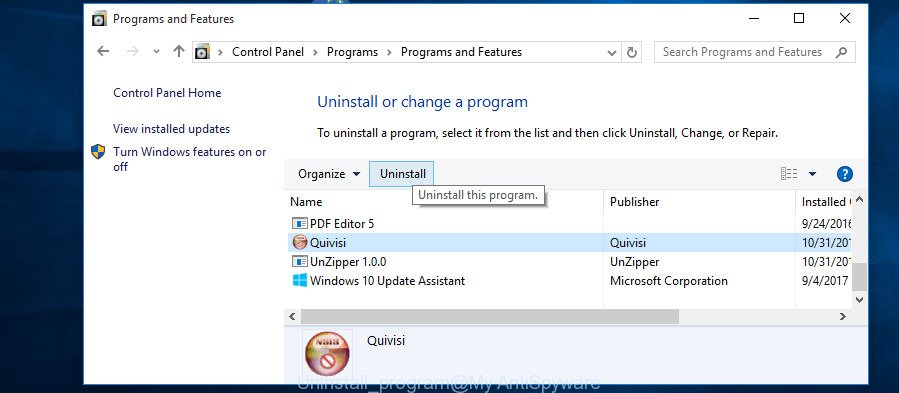
Look around the entire list of software installed on your device. Most likely, one of them is the Oxford Dictionary adware. Choose the dubious program or the program that name is not familiar to you and delete it.
Windows Vista, 7
From the “Start” menu in Windows, select “Control Panel”. Under the “Programs” icon, choose “Uninstall a program”.

Select the suspicious or any unknown programs, then press “Uninstall/Change” button to delete this undesired program from your PC.
Windows XP
Click the “Start” button, select “Control Panel” option. Click on “Add/Remove Programs”.
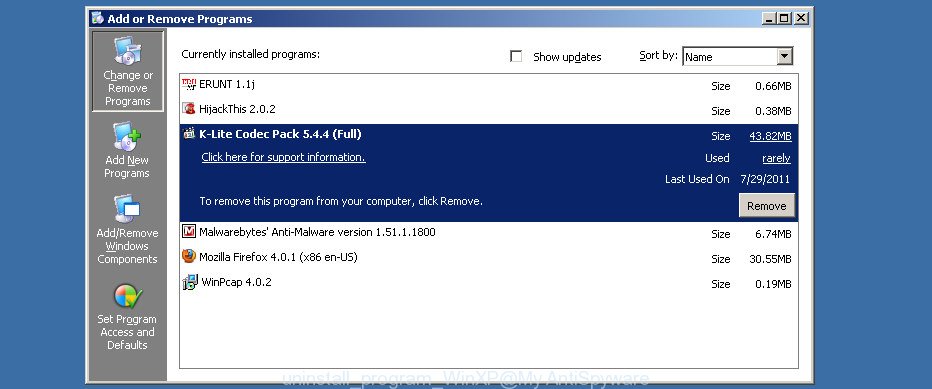
Choose an unwanted application, then click “Change/Remove” button. Follow the prompts.
Delete Oxford Dictionary adware from Internet Explorer
If you find that Internet Explorer internet browser settings such as default search provider, newtab and start page had been modified by the Oxford Dictionary adware, then you may restore your settings, via the reset web browser procedure.
First, launch the Internet Explorer. Next, press the button in the form of gear (![]() ). It will show the Tools drop-down menu, press the “Internet Options” as shown in the following example.
). It will show the Tools drop-down menu, press the “Internet Options” as shown in the following example.

In the “Internet Options” window click on the Advanced tab, then click the Reset button. The Internet Explorer will open the “Reset Internet Explorer settings” window as displayed below. Select the “Delete personal settings” check box, then click “Reset” button.

You will now need to reboot your computer for the changes to take effect.
Get rid of Oxford Dictionary adware software from Firefox
If Firefox settings are hijacked by the adware software, your internet browser displays annoying popup ads, then ‘Reset Mozilla Firefox’ could solve these problems. When using the reset feature, your personal information such as passwords, bookmarks, browsing history and web form auto-fill data will be saved.
First, start the Mozilla Firefox and press ![]() button. It will display the drop-down menu on the right-part of the internet browser. Further, click the Help button (
button. It will display the drop-down menu on the right-part of the internet browser. Further, click the Help button (![]() ) as shown below.
) as shown below.

In the Help menu, select the “Troubleshooting Information” option. Another way to open the “Troubleshooting Information” screen – type “about:support” in the internet browser adress bar and press Enter. It will display the “Troubleshooting Information” page as displayed in the following example. In the upper-right corner of this screen, press the “Refresh Firefox” button.

It will show the confirmation dialog box. Further, click the “Refresh Firefox” button. The Mozilla Firefox will start a procedure to fix your problems that caused by the Oxford Dictionary adware. When, it is finished, click the “Finish” button.
Remove Oxford Dictionary adware from Chrome
In this step we are going to show you how to reset Google Chrome settings. PUPs like the adware can make changes to your internet browser settings, add toolbars and undesired addons. By resetting Chrome settings you will remove Oxford Dictionary adware and reset unwanted changes caused by adware. Your saved bookmarks, form auto-fill information and passwords won’t be cleared or changed.

- First, start the Google Chrome and press the Menu icon (icon in the form of three dots).
- It will show the Chrome main menu. Choose More Tools, then click Extensions.
- You’ll see the list of installed addons. If the list has the extension labeled with “Installed by enterprise policy” or “Installed by your administrator”, then complete the following tutorial: Remove Chrome extensions installed by enterprise policy.
- Now open the Chrome menu once again, click the “Settings” menu.
- Next, click “Advanced” link, that located at the bottom of the Settings page.
- On the bottom of the “Advanced settings” page, click the “Reset settings to their original defaults” button.
- The Google Chrome will open the reset settings dialog box as shown on the image above.
- Confirm the web-browser’s reset by clicking on the “Reset” button.
- To learn more, read the blog post How to reset Google Chrome settings to default.
Automatic Removal of Oxford Dictionary adware
Best Oxford Dictionary adware removal utility should look for and delete adware software, malware, potentially unwanted applications, toolbars, keyloggers, browser hijackers, worms, Trojans, and popup generators. The key is locating one with a good reputation and these features. Most quality programs listed below offer a free scan and malware removal so you can look for and delete unwanted applications without having to pay.
Use Zemana Anti-Malware (ZAM) to remove Oxford Dictionary adware
Zemana is a program that is used for malicious software, adware, hijackers and PUPs removal. The program is one of the most efficient anti malware tools. It helps in malicious software removal and and defends all other types of security threats. One of the biggest advantages of using Zemana Anti-Malware (ZAM) is that is easy to use and is free. Also, it constantly keeps updating its virus/malware signatures DB. Let’s see how to install and check your personal computer with Zemana AntiMalware in order to remove Oxford Dictionary adware from your personal computer.

- Zemana Anti Malware (ZAM) can be downloaded from the following link. Save it directly to your MS Windows Desktop.
Zemana AntiMalware
164814 downloads
Author: Zemana Ltd
Category: Security tools
Update: July 16, 2019
- At the download page, click on the Download button. Your web-browser will show the “Save as” dialog box. Please save it onto your Windows desktop.
- Once downloading is complete, please close all apps and open windows on your personal computer. Next, start a file named Zemana.AntiMalware.Setup.
- This will run the “Setup wizard” of Zemana Free onto your device. Follow the prompts and don’t make any changes to default settings.
- When the Setup wizard has finished installing, the Zemana will open and display the main window.
- Further, press the “Scan” button for checking your personal computer for the Oxford Dictionary adware. A system scan can take anywhere from 5 to 30 minutes, depending on your computer. When a malware, adware or PUPs are detected, the number of the security threats will change accordingly. Wait until the the scanning is finished.
- When Zemana Anti Malware (ZAM) has completed scanning, Zemana Free will display a list of all threats found by the scan.
- Next, you need to click the “Next” button. The utility will delete Oxford Dictionary adware and move the selected items to the program’s quarantine. After finished, you may be prompted to restart the computer.
- Close the Zemana Free and continue with the next step.
Delete Oxford Dictionary and malicious extensions with HitmanPro
HitmanPro is a free portable program that scans your device for Oxford Dictionary , potentially unwanted programs and browser hijackers and helps remove them easily. Moreover, it will also allow you remove any harmful internet browser extensions and add-ons.
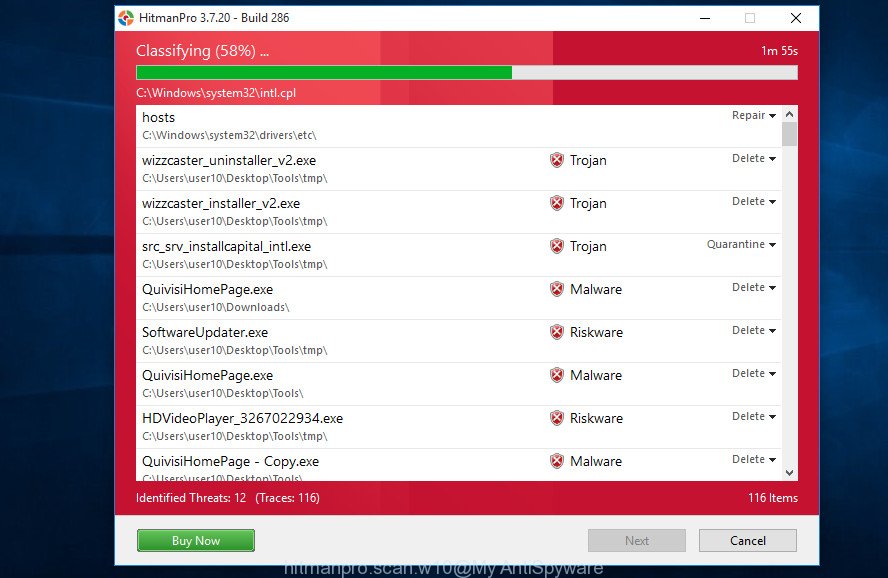
- Click the link below to download the latest version of Hitman Pro for Windows. Save it on your MS Windows desktop or in any other place.
- When the download is finished, double click the Hitman Pro icon. Once this utility is opened, click “Next” button to find Oxford Dictionary adware. A system scan can take anywhere from 5 to 30 minutes, depending on your PC. When a threat is detected, the number of the security threats will change accordingly. Wait until the the checking is done.
- Once Hitman Pro has finished scanning your device, Hitman Pro will prepare a list of unwanted apps and adware software. Next, you need to click “Next” button. Now click the “Activate free license” button to begin the free 30 days trial to delete all malicious software found.
Use MalwareBytes AntiMalware (MBAM) to remove Oxford Dictionary adware
Get rid of Oxford Dictionary manually is difficult and often the adware is not completely removed. Therefore, we advise you to use the MalwareBytes AntiMalware (MBAM) that are fully clean your computer. Moreover, this free program will allow you to delete malware, potentially unwanted applications, toolbars and browser hijackers that your device can be infected too.
Download MalwareBytes on your Microsoft Windows Desktop from the link below.
327071 downloads
Author: Malwarebytes
Category: Security tools
Update: April 15, 2020
When downloading is done, close all windows on your PC. Further, launch the file called MBSetup. If the “User Account Control” prompt pops up as displayed in the figure below, click the “Yes” button.
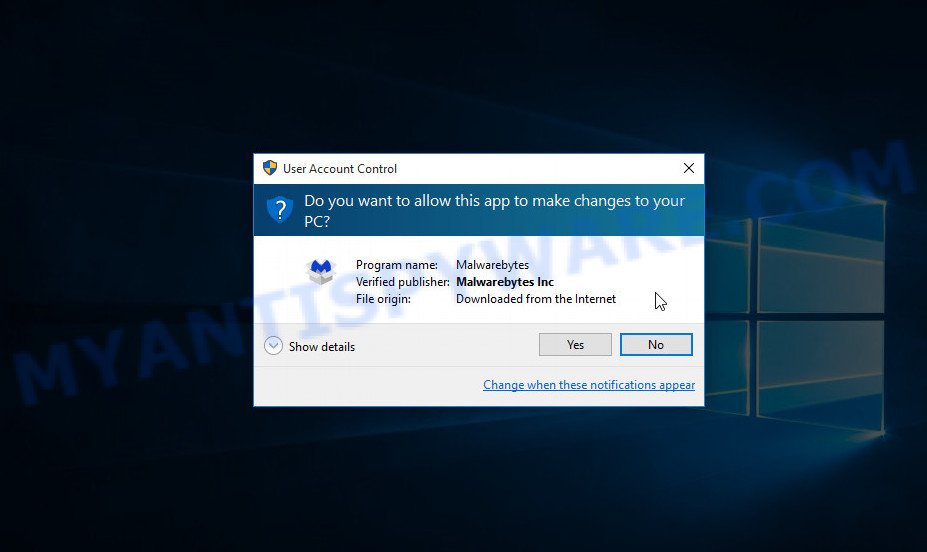
It will open the Setup wizard that will allow you install MalwareBytes on the computer. Follow the prompts and don’t make any changes to default settings.
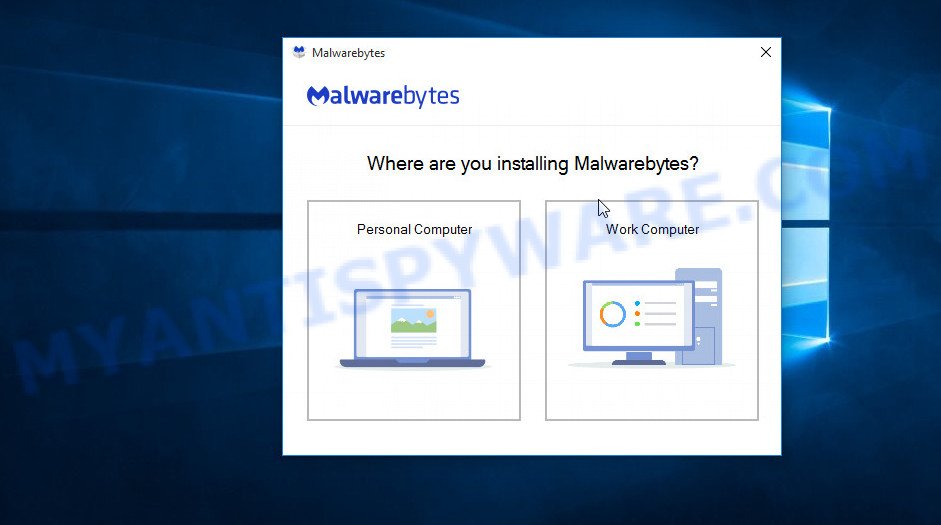
Once installation is complete successfully, press “Get Started” button. Then MalwareBytes Anti-Malware (MBAM) will automatically start and you can see its main window like the one below.
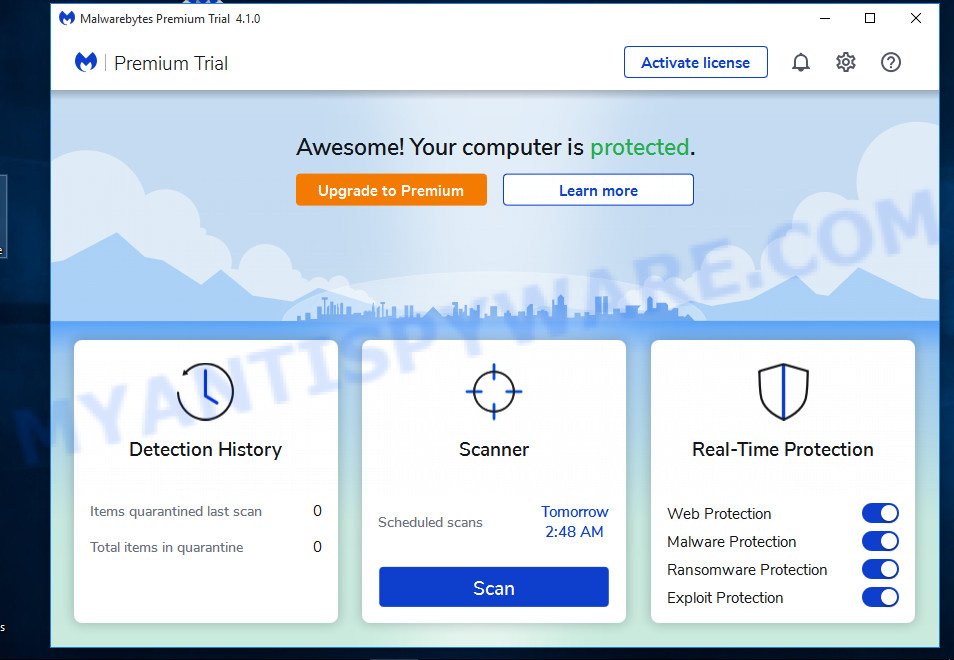
Next, click the “Scan” button for checking your PC for the Oxford Dictionary adware. This process can take quite a while, so please be patient. While the MalwareBytes Anti-Malware (MBAM) tool is checking, you can see how many objects it has identified as being affected by malicious software.
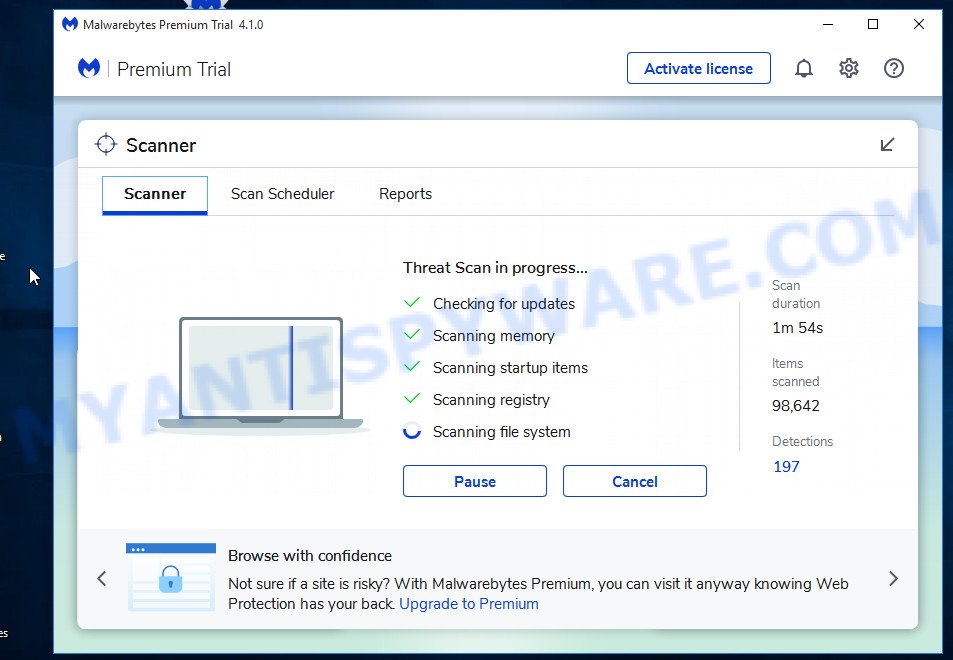
After MalwareBytes AntiMalware has finished scanning, MalwareBytes AntiMalware (MBAM) will produce a list of unwanted programs and adware software. When you’re ready, press “Quarantine” button.
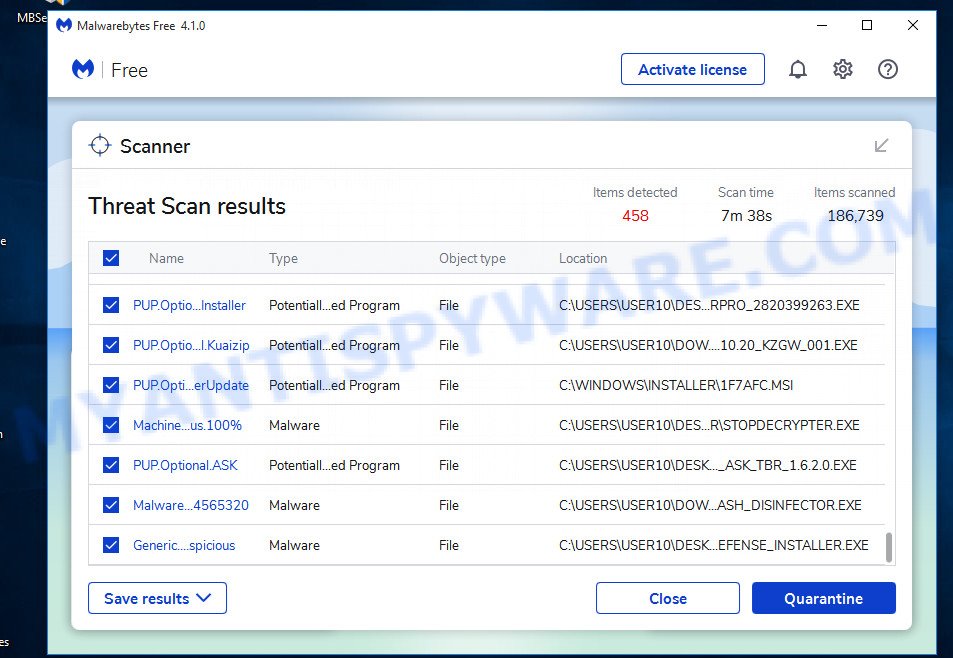
The MalwareBytes AntiMalware will begin to remove Oxford Dictionary adware. When finished, you can be prompted to restart your computer. We suggest you look at the following video, which completely explains the procedure of using the MalwareBytes AntiMalware (MBAM) to delete hijackers, adware and other malicious software.
How to stay safe online
Run an ad blocker tool such as AdGuard will protect you from harmful advertisements and content. Moreover, you can find that the AdGuard have an option to protect your privacy and stop phishing and spam webpages. Additionally, ad-blocker programs will allow you to avoid unwanted popup advertisements and unverified links that also a good way to stay safe online.
- Installing the AdGuard is simple. First you will need to download AdGuard on your personal computer by clicking on the link below.
Adguard download
26843 downloads
Version: 6.4
Author: © Adguard
Category: Security tools
Update: November 15, 2018
- Once the download is finished, start the downloaded file. You will see the “Setup Wizard” program window. Follow the prompts.
- Once the installation is complete, click “Skip” to close the setup application and use the default settings, or press “Get Started” to see an quick tutorial that will allow you get to know AdGuard better.
- In most cases, the default settings are enough and you don’t need to change anything. Each time, when you run your personal computer, AdGuard will run automatically and stop unwanted advertisements, block Oxford Dictionary redirects, as well as other harmful or misleading web pages. For an overview of all the features of the program, or to change its settings you can simply double-click on the icon called AdGuard, which is located on your desktop.
Finish words
Once you’ve finished the step-by-step instructions shown above, your PC should be clean from this adware software and other malicious software. The Firefox, Chrome, Edge and IE will no longer show any unwanted ads when you surf the Internet. Unfortunately, if the instructions does not help you, then you have caught a new adware software, and then the best way – ask for help.
Please create a new question by using the “Ask Question” button in the Questions and Answers. Try to give us some details about your problems, so we can try to help you more accurately. Wait for one of our trained “Security Team” or Site Administrator to provide you with knowledgeable assistance tailored to your problem with the Oxford Dictionary adware.


















